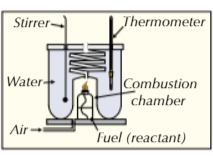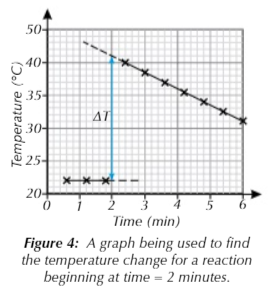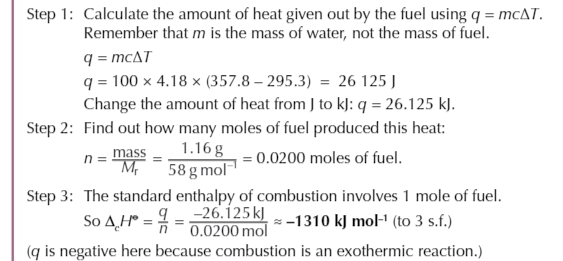2. measuring enthalpy change (CALORIMETRY)
1/14
There's no tags or description
Looks like no tags are added yet.
Name | Mastery | Learn | Test | Matching | Spaced |
|---|
No study sessions yet.
15 Terms
calorimetry experiments
measure the heat given out by reactions
reactions that occur in solutions
put reactants in a container that insulates heat to reduce heat loss/gain
use thermometer to measure temperature at regular intervals

you can find out how much energy is given out from combustion reactions by…
…measuring the temperature change it causes as it burns

to calculate the heat energy absorbed by water as fuel burns you need:
mass of water
temperature change ΔT
specific heat capacity of water 4.18 J g-1K-1
in practice heat will always be lost to the surrounding
this makes it hard to get accurate results
in practice some fuel is burnt via incomplete combustion
meaning less energy is given out
flammable liquids are often too volatile
so you may loose some of the fuel to evaporation
calculating temperature change
highest temperature recorded - initial temperature: this method is not accurate because of the heat lost from the calorimeter to surroundings
calculating accurate temperature change
during experiment record temperature at regular intervals stating a few minutes before the reaction starts
draw 2 lines of bets fit
extrapolate both lines so they both pass the time when the reaction started
the distance between both lines is the temperature change

equation to calculate enthalpy change
q=mcΔT
q=mcΔT units
q=heat lost/gained
m=mass in g of solution in polystyrene beaker
c=specific heat capacity of water, 4.18
ΔT=temperature change
calculating standard enthalpy change of combustion
calculate the amount of heat lost or gained using q=mcΔT REMEMBER YOU NEED TO CHANGE THE UNITS OF q FROM J TO KJ BECAUSE STANDARD ENTHALPIES OF COMBUSTION ARE ALWAYS IN KJ mol -1
calculate the number of moles of fuel caused the enthalpy change using n=Mass÷Mr
calculate the standard enthalpy of combustion using ΔcH∘=q÷n
ERRORS:
heat lost to surrounding
assums all solutions have water’s specific heat capacity
any heat absorbed by the apparatus is ignored
incomplete reaction
density of solution not the same as water
water evapourated
room temperature changed
incomplete conbustion of fuel
IMPROVE ACCURACY
Enclosed flame
burn fuel in pure oxygen

(๑•̀ㅂ•́)و✧
(๑•̀ㅂ•́)و✧
